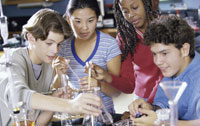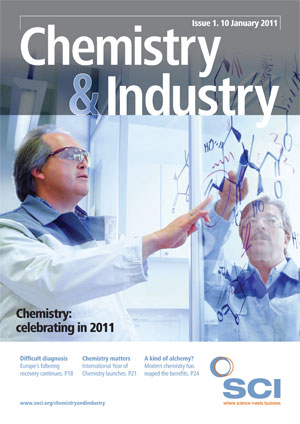Many readers will have seen the BBC documentary series: Chemistry: a volatile history, which was expertly narrated by Professor Jim Al Khalili. It charted the voyage of discovery that led to the understanding of states of matter and the molecular structure of our world. This understanding provided the basis for chemists to develop the processes and products on which the modern world depends: the nitrogen fertilisers that revolutionised agriculture; disinfection to provide safe potable water; pharmaceuticals for modern healthcare; energy systems to power our world and transport; and the myriad materials and functional products that surround you while reading this article. There is a lot to celebrate in 2011.
But is the best of chemistry behind us? As the series ended the focus changed to the science of the atomic nucleus – physics – with the implication that the future lies here rather than in chemistry. Al Khalili is, of course, professor of theoretical physics as well as holding the chair in Public Engagement in Science, at the University of Surrey, UK.
We face this question at a time when potentially negative impacts of some chemical technologies on our environment and on our health are becoming better understood. This lies behind rapidly changing chemicals regulation, such as REACH, and an apparently heightened aversion to risk in society in general. Some risks are real and require intervention, some have more to do with perception and some are simply uncertainties on which others choose to play.
It is why voluntary initiatives such as Responsible Care, which seeks to continuously raise industry standards, need to be seen to be effective. It is also why it is so important that chemistry engages the wider community in a mature and objective debate about the technologies that will be needed to address the challenges of sustainable development.
The challenges
The UN Declaration of 2011 as the International Year of Chemistry (IYC 2011) linked the year to the UN Decade of Education for Sustainable Development 2005-2014. The UN noted that chemistry will be pivotal in delivering its ambitions for sustainable development and its Millennium Goals.
The point is not that only chemistry can address such future challenges, but that it will enable the design and engineering and bio-engineering of likely responses to many of these problems. Many of the technologies we rely on today were developed in times of relatively abundant, cheap energy and when carbon footprints were something you left behind if you had activated charcoal on your laboratory shoes! The new processes will need radically lower energy intensity and result in products with significantly lower energy content. There will be a relentless focus on health and environmental impact, safety in use, and supply chain management that minimises waste and wastage.
The hand of chemistry will be everywhere, even in energy from nuclear power where chemistry will lie behind the materials for construction of the reactors, the processes to prepare nuclear fuels and the safe treatment and storage of nuclear waste.
In many cases, a step change will be required in performance. This may come about through new enabling science such as the molecular biology – that is, chemistry! – of the genome and its manipulation for health and agriculture.

The next expected step change is in motive power. The challenge for electric vehicles is to match or approach the power and energy densities of fossil fuels. A modern diesel car can be recharged/refuelled in minutes, it has a typical range of 500miles/800km and is entertaining to drive. Electric technology is some way from this today.
IYC 2011 opportunities
2011 is an opportune time to engage in the debate about sustainable development and the pivotal role of chemistry. The recent international years of physics and astronomy succeeded in raising an appreciation of these sciences, particularly amongst the young. There are a number of chemistry landmarks and distinguished chemists whose contributions we can celebrate this year. These include the contribution of women in chemistry, exemplified by the centenaries of Marie Curie’s Nobel prize and of the founding of the International Association of Chemical Societies, the forerunner of International Union of Pure and Applied Chemistry (IUPAC).
The proposal for an International Year was approved in 2007 by IUPAC, and was designated by UNESCO (United Nations Education, Science and Cultural Organisation) in April 2008. The Year’s activities will reflect a mix of activities designed to engage those in governments, industry, trades unions and civil society. There are four main objectives:
- To increase the public appreciation and understanding of chemistry;
- To encourage interest of young people in chemistry;
- To generate enthusiasm for the creative future of chemistry, especially in meeting the challenges of sustainable development; and
- To celebrate chemistry and in particular the role of women in chemistry.
The bulk of activities will be organised nationally, with chemistry societies around the world taking a lead to ensure IYC 2011 has relevance and a cultural resonance in their countries. France is organising a project, for example, called ‘the 5 Reporters’ in which five young people will be selected to go to five countries to video important chemistry developments in sustainability and to interview those working on these topics.
Globally, the year is coordinated through a central website: www.chemistry2011.org, which shows the objectives, a schedule of events, how to engage in the year, who has already engaged, their project ideas and the national coordinators in each country. It also outlines the opportunities for those wishing to sponsor the year financially or through direct involvement.
Planned activities
IUPAC and UNESCO are organising a small number of global ‘Cornerstone Events’ and global activities as important markers of the themes for the year. These events will bring together industry and academic scientists, and those in government and the international agencies who set the policy context for innovation, to seek new ways of accelerating the contribution of chemistry to sustainable development. The inaugural event in Paris will set the scene, the World Chemistry Leadership meeting in San Juan in Puerto Rico will seek new approaches to international collaboration and the closing event in Brussels will look to the future industrial implementation of chemistry. Global activities will be important for engaging larger numbers of people. ‘Women sharing a chemical moment in time‘ is being organised at many locations, linked virtually, to enable participants to discuss and compare women’s role and contributions to chemistry within their cultures.
The experiment on ‘Water: a chemical solution’ will involve schoolchildren across the world in the biggest ever chemistry experiment (C&I, 2010, 19, 7). It is an opportunity for young children to learn safely about the power of chemistry to understand the world and its ability to provide solutions to key challenges. The experiment comprises investigations of local water quality and of purification. It will be coordinated globally to provide resources in the main UN languages, data logging and visualisation of results using Google Earth. The experiment is an opportunity for industrial chemists to help and support local schools, and for businesses to support it financially, or by facilitating implementation (www.chemistry2011.org/water).
Engage!
The UN International Year of Chemistry 2011 provides the context for us all to celebrate the contributions of chemistry to modern life and to anticipate its contributions in the future. It provides an opportunity for everyone to engage; a large number of really creative projects are already proposed and can be viewed on chemistry2011 and national websites. The challenges of sustainable development are immense and chemistry will play a central role in addressing them – this is why its best is certainly not behind it and why chemistry still matters.
Chemistry rising to the challenges
1. Food: by 2050 food production will need to double through efficient agronomic practice, whilst reducing the impact of agricultural waste, implementing effective pest control, improved nutrient use by plants, understanding soil science and efficient land and water use – a strategy for which the term ‘sustainable intensification’ has been coined.
2. Water and air quality: access to clean drinking water is already a major challenge and demand will only grow. Finding low energy routes to water purification from poorer quality resources is a priority, as is effective mitigation of poor air quality in densely populated areas.
3. Urban environments: most people live in towns and cities, often spending long periods indoors. Population density poses major challenges for the provision of services, the handling of waste, and the environmental impact of transport systems, where construction systems and materials need to meet the demands for low cost housing and shelter with healthy indoor living environments.
4. Human health: there is increasing demand for ever more effective diagnostics, drugs and therapies, infection control and, in many developed countries, improvements to the quality of extended life for the elderly.
5. Lifestyle and recreation: chemistry enriches people’s lives through its impacts on art, fashion, information technology, sports goods and other recreational pursuits.
6. Raw materials and feedstocks: pressure is increasing to conserve scarce resources, to find sustainable alternatives including biomass and to ensure effective recycling through innovation design across the product life cycle.
7. Energy: to power the new world we need to manage a gradual transition from fossil fuels to more sustainable sources with improved energy storage and conservation.
The above challenges can also be found listed at: http://www.rsc.org/ScienceAndTechnology/roadmap/
Colin Humphris is a member of the UN International Year of Chemistry Management Committee, based in Clymping, West Sussex, UK.





